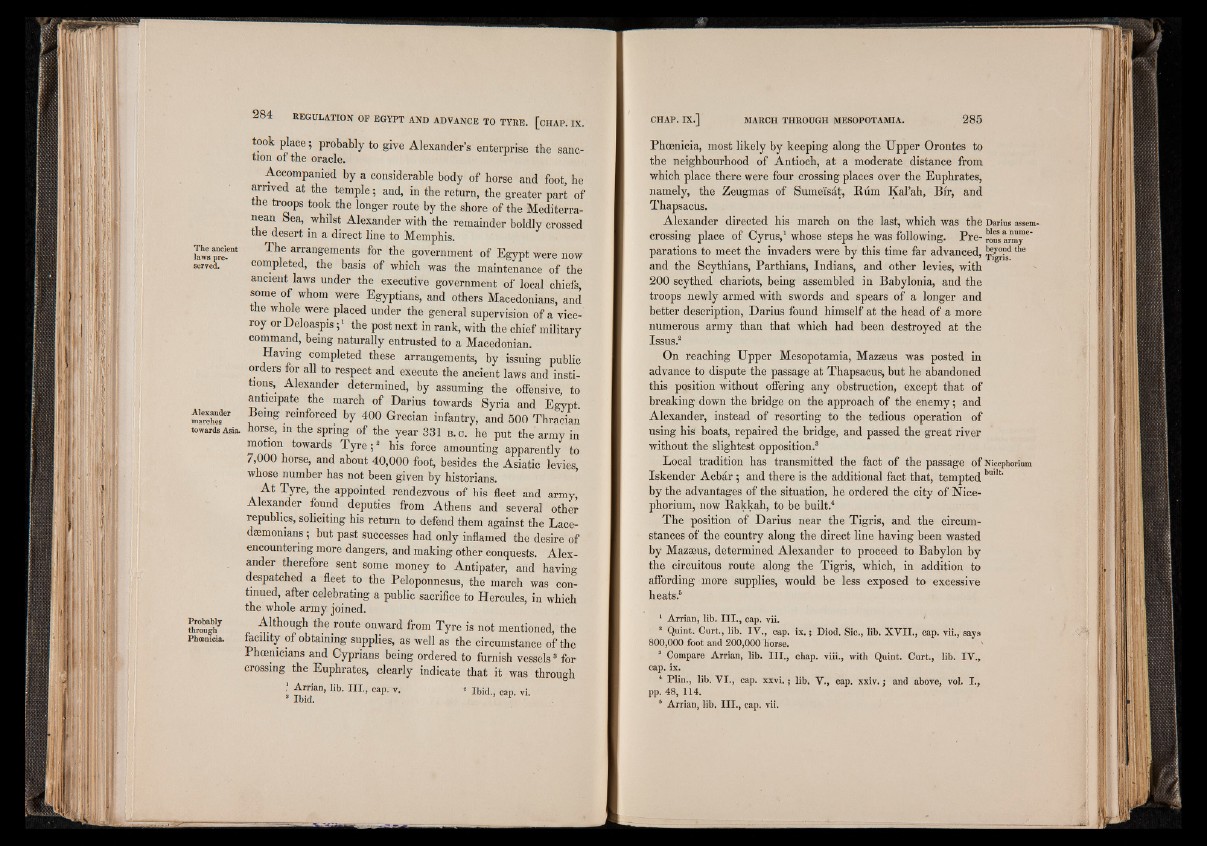
The ancient
laws preserved.
Alexander
marches
towards Asia.
Probably
through
Phoenicia.
took place; probably to give Alexander’s enterprise the sane-
tion of the oracle.
Accompanied by a considerable body of horse and foot, he
arrived at the temple; and, in the return, the greater part of
tr°°Ps took the longer route by the shore of the Mediterranean
bea, whilst Alexander with the remainder boldly crossed
the desert in a direct line to Memphis.
The arrangements for the government of Egypt were now
completed, the basis of which was the maintenance of the
ancient laws under the executive government of local chiefs,
some of whom were Egyptians, and others Macedonians, and
the whole were placed under the general supervision of a viceroy
or Deloaspis %1 the post next in rank, with the chief military
command, being naturally entrusted to a Macedonian.
Having completed these arrangements, by issuing public
orders for all to respect and execute the ancient laws and insti-
tions, Alexander determined, by assuming the offensive, to
anticipate the march of Darius towards Syria and Egypt.
Being reinforced by 400 Grecian infantry, and 500 Thracian
horse, m the spring of the year 331 b. c. he put the army in
motion towards T y r e ;8 his force amounting apparently to
7,000 horse, and about 40,000 foot, besides the Asiatic levies,
whose number has not been given by historians.
At Tyre, the appointed rendezvous of his fleet and army,
Alexander found deputies from Athens and several other
republics, soliciting his return to defend them against the Lacedaemonians
; but past successes had only inflamed the desire of
encountering more dangers, and making other conquests. Alexander
therefore sent some money to Antipater, and having
despatched a fleet to the Peloponnesus, the march was continued,
after celebrating a public sacrifice to Hercules, in which
the whole army joined.
Although the route onward from Tyre is not mentioned, the
frcility of obtaining supplies, as well as the circumstance of the
Phoenicians and Cyprians being ordered to furnish vessels3 for
crossing the Euphrates, clearly indicate that it was through
’ Arrian, lib. I I I ., cap. v. « ibid Cap. vi.
Ibid.
Phoenicia, most likely by keeping along the Upper Orontes to
the neighbourhood of Antioch, at a moderate distance from
which place there were four crossing places over the Euphrates,
namely, the Zeugmas of Sumei'sat, Rum Kal’ah, Bir, and
Thapsaciis.
Alexander directed his march on the last, which was the Darius assem-
crossing place of Cyrus,1 whose steps he was following. Pre- tous army16"
parations to meet the invaders were by this time far advanced, [fgp f the
and the Scythians, Parthians, Indians, and other levies, with
200 scythed chariots, being assembled in Babylonia, and the
troops newly armed with swords and spears of a longer and
better description, Darius found himself at the head of a more
numerous army than that which had been destroyed at the
Issus.2
On reaching Upper Mesopotamia, Mazseus was posted in
advance to dispute the passage at Thapsacus, but he abandoned
this position without offering any obstruction, except that of
breaking down the bridge on the approach of the enemy; and
Alexander, instead of resorting to the tedious operation of
using his boats, repaired the bridge, and passed the great river
without the slightest opposition.3
Local tradition has transmitted the fact of the passage of Nicephorium
Iskender Acbar; and there is the additional fact that, tempted built'
by the advantages of the situation, he ordered the city of Nicephorium,
now Rakkah, to be built.4
The position of Darius near the Tigris, and the circumstances
of the country along the direct line having been wasted
by Mazseus, determined Alexander to proceed to Babylon by
the circuitous route along the Tigris, which, in addition to
affording more supplies, would be less exposed to excessive
heats.6
1 Arrian, lib. I I I . , cap. vii.
2 Quint. Curt., lib. IV ., cap. ix . ; Diod. Sic., lib. X V I I ., cap. vii., says
800,000 foot and 200,000 Horse.
3 Compare Arrian, lib. I I I ., chap. viii., with Quint. Curt., lib. IV.,
cap. ix.
4 Plin., lib. V I., cap. x x v i.; lib. V., cap. x x iv .; and above, vol. I .,
pp. 48, 114.
6 Arrian, lib. I I I ., cap. vii.